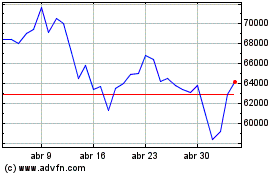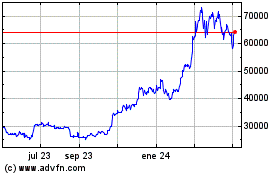Is Bitcoin Really Safe? New Insights from ‘Black Swan’ Author on Recent Crash
07 Agosto 2024 - 12:00AM
NEWSBTC
Bitcoin has led a global crypto market downturn in the past few
days, with the asset down to as low as $49,751 on August 5. This
significant plunge from Bitcoin has been attributed by many to the
downturn in the Japanese markets. The Trigger in Japan Speaking on
the crash, Nassim Nicholas Taleb, a risk analyst, author of “The
Black Swan” and a well-known Bitcoin detractor, sheds light on
the origins of the recent market disruptions that have rippled
through to cryptocurrencies. Related Reading: Could Bitcoin
Outshine Gold? Trading Guru Weighs In On The Historic Financial
Duel On Monday, the Japanese stock market fell severely, dropping
by more than 10%. The report said this plunge came
“amid risk from a stronger yen, tighter monetary policy, and
concern over the US recession.” The narrative begins with Japan’s
economic policies, where after maintaining zero interest rates for
an unprecedented thirty-three years coupled with nearly two and a
half decades of quantitative easing, the Bank of Japan (BOJ) found
itself cornered into a position where adjustments seemed
inevitable. The abrupt decision by the BOJ to raise interest rates
led to a sharp downturn in the Nikkei 225, a major stock index,
which in turn sent shockwaves across global markets, including the
cryptocurrency sector. According to Taleb, this sharp pivot in
policy was a long time coming, as the artificial suppression of
interest rates and excessive liquidity injection often come with
hefty long-term costs. The Japanese approach, often hailed as a
successful quantitative easing model, now faces critical
scrutiny as it appears the bill for years of economic manipulation
is due. Taleb particularly noted in the post on X: Nearly 33 years
of (near) Zero Interest Rates (ZIRP) and 23 years of Quantitative
Easing come at a price you eventually must pay. (Japan was always
mentioned by the QE fools as a place where the strategy worked). Is
Bitcoin Safe? Bitcoin dipped to a 7-month low during the global
market plunge, dropping below $50,000. This fall impacted the
crypto market so much that the total liquidations surpassed $1
billion. Given this significant negative impact attributed to the
plunge in the Japanese market, some might question if Bitcoin is
still safe, especially as a safe haven. However, it is worth noting
that Bitcoin has since proved to be a digital asset worth
considering as a safe haven when it comes to times like this. In
March 2023, when major banks in the US were collapsing, Bitcoin saw
a rise to as high as $29,000—a notable increase from its lowest
levels below $20,000 that month. Besides, it is also
worth noting that not only Bitcoin was a victim of the impact of
this Japanese market crash, as several other major crypto assets,
including Ethereum and Solana, experienced a drastic fall. For
context, Ethereum fell as low as $2,197—a low not seen since
January of this year; Solana also bore the brunt, dipping to $110.
Aside from these major cryptocurrencies, traditional assets also
received their share of impact, with Nvidia, Tesla, and Apple
falling at least 4%. Related Reading: Investors Pull Back: $528
Million Vanishes From Crypto Funds Amid Economic Fear This shows
that the recent crash didn’t suggest that Bitcoin was unsafe
enough; instead, it reveals its correlation to changes in the
global economic sector. Featured image created with DALL-E, Chart
from TradingView
Bitcoin (COIN:BTCUSD)
Gráfica de Acción Histórica
De Oct 2024 a Nov 2024

Bitcoin (COIN:BTCUSD)
Gráfica de Acción Histórica
De Nov 2023 a Nov 2024
